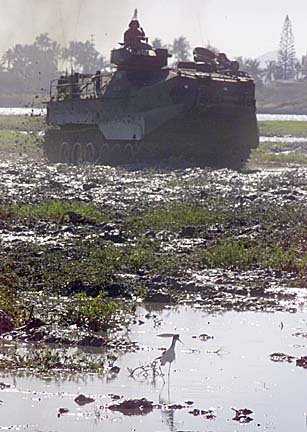


|
Marines get dirty It's monster truck rally time in Windward Oahu -- Marine Corps style, with 26-ton, tracked assault vehicles tearing up the mud flats all in the name of the environment.
for the birds
The annual "mud ops"
at Nuupia Ponds preserve
endangered speciesBy Gregg K. Kakesako
gkakesako@starbulletin.comIn fact, for more than two decades it's been a unique island tradition where the these behemoths of the 3rd Marine Regiment's armored assault vehicle platoon attack the mud flats of the Nuupia Ponds Wildlife Management Area, home of 50 native Hawaii birds.
The annual "mud ops" program has been conducted every January since 1982, according to Diane Drigot, senior natural resources management specialist for Marine Corps Base Hawaii. "It creates the perfect harmony between the military and nature since it helps Hawaii's endangered birds and helps train Marines for their next exercise."
The two-day exercise uses at least five armored assault vehicles from Kaneohe Bay's Combat Service Support Company, 3rd Marine Regiment, to plow up invasive plant species that would otherwise overrun the ponds and crowds out the endangered birds from their homes."

|
Sgt. Jared Genco, a driver of for one of the 16 assault vehicles maintained by his Kaneohe Bay platoon, compared it "to going to a monster truck rally.""It also shows a different aspect of the Marine Corps," said Genco, 22, "where we actually stand up for the environment."
Second Lt. Houston Evans, commander of the assault amphibious vehicle platoon, said the exercise also gives his Marines the chance to practice recovery techniques. "It's good training us," Evans added, "since it gives us a chance to practice recovering vehicles that get stuck in the mud."
Drigot said no other organization can provide vehicles with so much weight that literally flatten and crush invasive plant species such as the lime green pickleweed, which has invaded the Nuupia Ponds.
"If not plowed back every year with the assistance of the Marines and their AAVs," Drigot said, "the pickleweed mass would grow so thick that the stilt and the other waterbird species that use Nuupia mudflats would have no maneuver room or available mudflat for foraging for food or for nesting."
She said a typical Hawaiian stilt nest is a scrape or depression the birds have made with their beaks in an island-like mud mound, surrounded by a "moat" of water. This watery boundary around each nest site assures the hatchlings a source of nearby food, such as small fish, shell fish and brine flies.
Drigot said that stilt parents will perform protective maneuvers to guard their young but do not feed them directly. The watery moat around their muddy nest mounds also provides some protection from predators.
"By plowing up the pickleweed each year," Drigot said, "we are keeping the invasive weeds under control while providing a more desirable hill and valley island and moat terrain ideal for bird foraging and nesting."
From the air, the pattern heavy tracked vehicles create looks like a gigantic checkerboard, Drigot said. "The birds like to follow the vehicles because they stir up the mud exposing fly larvae, bugs, tiny fish and other food."
The "mud ops" are timed to precede the breeding period since the birds tend to nest in late January to February and then breed in March and April. "Eggs are laid in May to June," Drigot added, "and take about 26 days to incubate."
In addition, throughout the year, her staff controls human uses around the edges of the wetland, which has been protected since 1966. They also protect and control the quality of the water that runs off the land into the ponds, and trap and remove predators such mongooses that prey upon protected birds and their young.
During the past 20 years, with the help from thousands of volunteers and more than $2 million of contracted work, another major invasive plant, mangrove trees, which were displacing the birds from their habitat, were removed from the ponds.
The 482-acre Nuupia Ponds Wildlife Management Area at the neck of the Mokapu Peninsula is "one of the few precious wetlands left in Hawaii," Drigot said.
Before Capt. James Cook arrived in the islands, there were 20,000 acres of wetlands, she said. "Over the last 200 years, we have lost one-third of the these wetlands. Eighty percent are now located on Oahu, with 500 acres in Windward Oahu."
Since the "mud ops" were started two decades ago, the bird population in the salty ponds has doubled, Drigot said. "There were about 60 Hawaiian silts in 1980 and we are up to 130 now," she added.
The "mud ops" evolved because of a problem that occurred in the 1970s, Drigot said. "The stilts were following the 26-ton tracked AAVs as they traveled along the northern shoreline mudflat edges of Nuupia Ponds on their daily transit to the ocean at Kailua Bay. The birds were attempting to nest on mounds of mud along the watery trail left behind as the vehicles traveled along their transit corridor to splash down in the ocean. However, by establishing nest sites along a busy travel corridor, the birds and their nests were placed in jeopardy."
A compromise was worked out with the U.S. Fish and Wildlife Service and state conservation officials and the Marines moved their transit corridor farther north and "what could have been a problem turned into an opportunity," Drigot added.